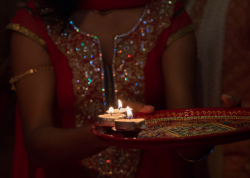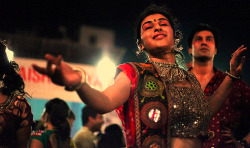THE NAVRATRI POST
Navratri is a combination of two words. 'Nav' means nine while 'ratri' means night. Therefore, this celebration is literally translated as 'nine nights'. The celebrations begin on the first day of the month of Ashvin according to the lunar Hindu calendar. They culminate in the festival of Dassera, on the tenth day of the month. As per the Gregorian calendar, Navratri always falls in the month of October.
The festival of Dassera is celebrated to worship God's triumph of good over evil, in this case through Maa Durga. She is the embodiment of Devi, or the supreme goddess. The form of the Goddess Durga is said to symbolise creative energy and the feminine body. This form of the Goddess has nine aspects. Navratri therefore is dedicated to the worship of these aspects. Each form or aspect of the Goddess has its own day dedicated to it.
The Navratri celebrations are devoted to the worship of the Eternal Mother. Durga is also considered to be a combination of the Trinity of Goddesses. They are Parvati, Lakshmi and Saraswati. During Navratri, these three main Goddesses too, are worshipped within their central themes of the triumph of good over evil. Each night is celebrated with circular dancing known as Garba and the reenactment of the Devi's victories through Raas.
The First Three Days of Navratri
The first three days of Navratri are devoted to the praise of the Goddess Durga. This is the period, when Her energy and power are worshipped. Each day is dedicated to a different appearance of Durga. Kumari, which signifies the girl child, is worshipped on the first day of the festival. Parvati, who is the embodiment of a young woman and wife of Lord Shiva, is worshipped on the second day. The destructive aspects of Goddess Durga symbolize the commitment to acquire triumph over all evil tendencies. Hence, on the third day of Navratri, Goddess Kali is worshipped, who represents the final and most powerful phase of destruction.
Fourth to Sixth Days of Navratri
When a person acquires triumph over evil tendencies of ego, anger, lust and other animal instincts, he/she experiences a void. This void is filled with spiritual wealth. For this purpose, one approaches Goddess Lakshmi to acquire all the materialistic, spiritual wealth and prosperity. This is the reason why the fourth, fifth and sixth day of Navratri are dedicated to the worship of Lakshmi - the goddess of prosperity and peace.
Seventh to Eighth Days of Navratri
Although the individual has acquired victory over evil tendencies and wealth, he is still deprived of true knowledge. Knowledge is required to live the life of a Hindu, even though he/she is prospered with peace of mind and spiritual wealth. Therefore, Goddess Saraswati, the Goddess of art and knowledge is worshipped on the seventh to eighth days of Navratri. A 'yagna' is also performed on the eight day. This comprises of offerings and prayers honoring goddess Durga and bids Her farewell. The sacrifice or offering is made out of clarified butter (ghee), rice pudding known as kheer and sesame seeds.
Ninth Day of Navratri
The ninth day is the final day of Navratri celebrations, Dassera or Mahanavami. This marks the final victory over two major battles in Hindu history- the triumph of Lord Ram over the demon king Ravana and the victory of Maa Durga over the demon Mahishasura. The combination of the two victories is celebrated through playing Raas Leela; a giant communal dance played with the clacking of dandiya sticks to symbolize battle.
MAY EVERYONE RECEIVE THE BLESSINGS OF MAA DURGA THIS YEAR!
ॐ HAPPY NAVRATRI!ॐ




No comments:
Post a Comment